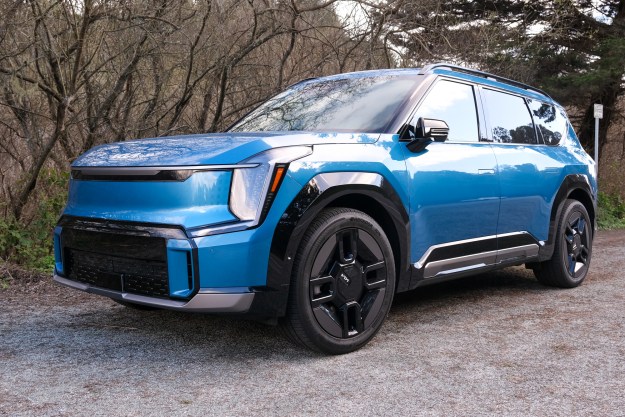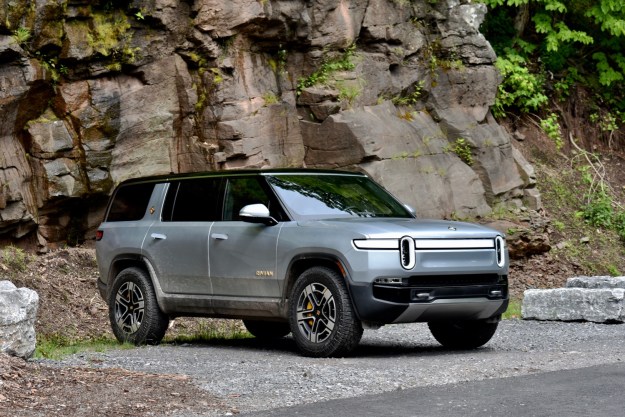There’s a moment behind the wheel of the Faraday Future FF91 when it hits you: The sheer shock of 1,050 horsepower, the instant acceleration of an electric motor that can take you from a standstill to 60 mph in 2.3 seconds.
For me, it happened at around 50 mph on the streets of Las Vegas on Sunday, the day before CES 2020 officially kicked off. This is one of the best cars we’ve seen at the show this year.
More Cars at CES 2020
I was approaching a traffic signal on Sierra Vista Drive that had just turned yellow and mashed the pedal to jump through the light. The car blasted forward like a spaceship striving for orbit while my insides danced around, excitement wrestling with sheer terror and the Bavarian pretzels with Easy Cheese I wolfed down earlier in the day.
There’s a moment when you realize what g-forces feel like. There’s a moment where you realize that the power of an electric motor is nothing like a gas engine, which lacks torque at the top and bottom of each gear. Put simply, gas-powered cars lack oomph when you need it.
This car? Not at all. That means you can drive differently. You don’t wonder whether you have enough power to pass that slow driver ahead. It’s just a question of when. You don’t wonder if you’ll make the light. It’s just a question of how far down the road you’ll be when you let up on the pedal.
Faraday Future has burned through a billion dollars building the FF91, which CEO Carsten Breitfeld told me will go on sale to the public before the end of 2020. As the first journalist in the world to test drive the car — the sandstone-colored version, code-named G2-18 – it feels worth every penny.
What does zero to sixty in 2.3 seconds feel like? It feels like victory.
The vehicle design

To be fair, Faraday’s FF91 is not ready for prime time yet. The car I drove was a prototype. Breitfeld and Bob Kruse, SVP of product execution, drove it from company headquarters in Los Angeles to Las Vegas on Sunday, a 270-mile trip that would tax the range of any electric car, even without the extra strain from driving through the mountains between.
Breitfeld says they stopped at a Tesla Super Charger station along the way, though only to chuckle at the people marooned there. The Tesla Model 3 has a range of up to 325 miles, although the company sells long-range versions of the Model S that can handle 375 miles. Faraday claims a range closer to 400, though final numbers remain to be ironed out.
The pair of FF91s landed in Vegas with over a hundred miles of range left. I burned through a few of the remaining miles myself racing up and down the strip.
The passenger experience is heaven.
The engine might be ready, but details remain as unpolished as the touchscreens, which had a few smudges from the day’s wear and tear. The car has four doors that open outward at the press of a button or by speaking a command. They didn’t always work.
The car’s controls are essentially done, but they’re not fool-proof. When shifting from Park to Drive, for example, the stick didn’t lock into place with as satisfying of a click as I would have liked. And the turn signals were hard to turn on and off. These issues will be solved before the car goes on sale, I’m told.
There were bigger details. An exposed circuit board and wiring harness sat under the passenger side seat, and I was told to push a giant red button if I felt like I was losing control of the car. To be clear, I never felt out of control — but the need for the button shook me. Keep in mind, this is the prototype GS-18, not a final car. I didn’t need a reminder that crashing the multi-million dollar vehicle was a possibility.
The driver’s seat was comfortable, and the array of 11 screens that surround passengers in the car were wonderfully responsive. They were much like a smartphone or tablet screen. And the back seat? Ahhh, the back seat is a dream.
Chinese customers are far more likely to be driven around than American customers, the company told me. And if that’s you, you’re in for a treat. The passenger experience is heaven. The car is long, affording room for seats that recline all the way. The cabin is enormous. Turn on spa mode, and the seat goes back, the lights get all dreamy, and soothing music and visuals play on a 42-inch screen that hangs down from the ceiling. I don’t need my hotel room, I thought. I can sleep here.
The backstory

Breitfeld is no stranger to electric cars. Before joining Faraday he was head of BMW i, a sub brand of BMW dedicated to electric cars. While there he oversaw the launch of the BMW i3 and the i8 plug-in hybrid sports cars — two radical designs from one of the auto industry’s biggest players.
Breitfeld also helped start Chinese electric-car startup Byton, and most recently served as CEO of another Chinese firm, Iconiq Motors. Kruse joined more recently, coming from Karma, one of the big competitors in the space.
For a thorough history of Faraday, read the excellent long-form feature by The Verge’s Sean O’Kane. Here’s the short version: A streaming media company called Letv made a splash at CES 2016 with its new cell phones, and the broad ambitions of the company and its founder, Jia Yueting, quickly emerged. The company would be LeEco, and it would make everything, even electric cars. At least, that was the plan.
The company continued pouring hundreds of millions into R&D, hiring the smartest engineers and designers in dogged pursuit of its dream.
While Yueting burned through billions, he secretly founded another company in California. That company was Faraday. Le Eco collapsed under the weight of its debt, and Faraday groaned along with it, but the company continued pouring hundreds of millions into R&D, hiring the smartest engineers and designers in dogged pursuit of its dream.
The technology
Much of the money poured into the FF91 went to technology, which explains some of what the car can do. Take the batteries, for example. They’re liquid cooled, solving part of the thermal challenge and aiding with range. The car not only has all-wheel drive, but also four-wheel steering, meaning the rear wheels pivot to give it a tight turning radius.
The interior looks ripped from a sci-fi movie. There’s an LCD panel where the instrument cluster should be, and three 4G LTE connections that power various infotainment options. There’s also facial recognition built in, to identify the car’s passengers and customize to their needs, including the radio stations they like to listen to, and temperature preference.
It’s been an easy joke that Faraday Future was a look at the faraway future, as the company struggled to build something it would never achieve. If the company can polish it up and finish it off, however, the FF91 will be justification for all the money it has spent. The future isn’t that faraway after all.
Follow our live blog for more CES news and announcements.
Editors' Recommendations
- Hyundai Ioniq 6 first drive review: welcome to the future
- Faraday Future plans shuttle service between Los Angeles and Las Vegas
- All the insane car tech (and one motorcycle) we can’t wait to see at CES 2020




